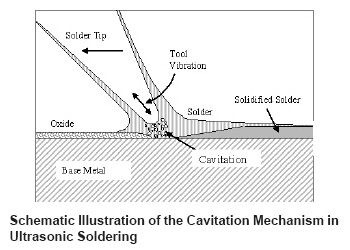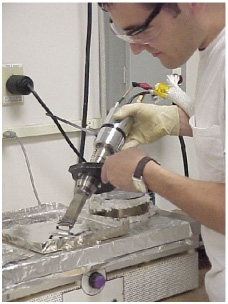S-Bond® active solders are very effective in combination with ultrasonic soldering for a range of applications. Ultrasonic soldering (U/S) is a fluxless soldering process and is finding growing application in soldering of metals and ceramics from solar photovoltaics and medical shape memory alloys to specialized electronic and senor packages. U/S soldering has been reported since 1955 as a method to solder aluminum and other metals without the use of flux. The reason for expanding usage is that ultrasonic soldering is a fluxless process.
U/S soldering uses either ultrasonically coupled (piezoelectric ) heated solder iron tips (0.5 – 10 mm) or solder baths. These devices generate high frequency (20 – 60 kHz) acoustic waves to mechanically disrupt oxides that form on the molten solder surfaces and/or initiates cavitation in the solder pool which also mechanically disrupt oxide layers that naturally formed on metal surfaces being joined. Cavitation in the molten solder pool can be very effective in disrupting the oxide on many metals, however, it is not effective when soldering to ceramics and glass since they themselves are oxides or other non-metal compound that cannot be disrupted since they are the base materials. A schematic of the U/S soldering process is illustrated below.

U/S soldering consists of heated soldering tips coupled to a piezoelectric crystal that is powered by an acoustic amplifier operating at 20 – 60 KHz. The tips for U/S soldering irons are also coupled to a heating element while the piezoelectric crystal is thermally isolated, not to degrade the piezoelectric element. The tip thus can heat (up to 450°C) and mechanically oscillate at 20 – 60 KHz. This soldering tip can melt solder filler metals as acoustic vibrations are induced in the molten solder pool. The vibration and cavitation in the molten solder then permits solders to wet and adhere to many metal surfaces. Initially, U/S soldering aimed at joining aluminum and other metals; however, with the emergence of active solders, much wider range of materials can be soldered c using ultrasonics as a form of mechanical activation.
U/S soldering is now expanding in application, since fluxless active solders are increasingly being requested for joining assemblies where either corrosive flux can be trapped or otherwise disrupt operation or contaminate clean production environments or there are dissimilar materials / metals / ceramic/ glasses being joined. In this expanded list of materials, active solders’ own nascent oxide on melting need to be disrupted and U/S agitation is well suited.

Active solders such as S-Bond and other activated solders that use rare earth elements, Ti, Hf, Zr or even indium all form a tenacious oxide on their molten surfaces and conventional solder fluxes to not disrupt these. In applications where the area of the solder joint is a small or band, U/S soldering using 1 – 10 mm tips can be very effective since the volume of molten metal is small and can effectively be agitated by the 1 – 10 mm U/S soldering iron tips. The figures in this article show the U/S soldering equipment (power supply and soldering tools-tips) and the application of solder to glass using U/S solder iron tips. In other larger surface bonding application, as shown in the image below, wide, heated U/S tips are being used to spread and wet active solders on large aluminum surfaces (and is applicable to other metal, ceramic and glass surfaces.

One can see that with the commercial introduction of active solders, such as S-Bond®, U/S soldering has expanded well past it use to aluminum and is finding wider and wider application. S-Bond Technologies maintains a U/S soldering development laboratory and offers both development and production services. Contact Us to evaluate if U/S soldering can be beneficial and applicable in your applications.
